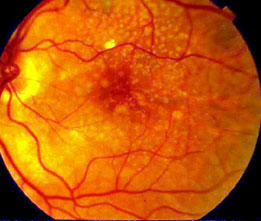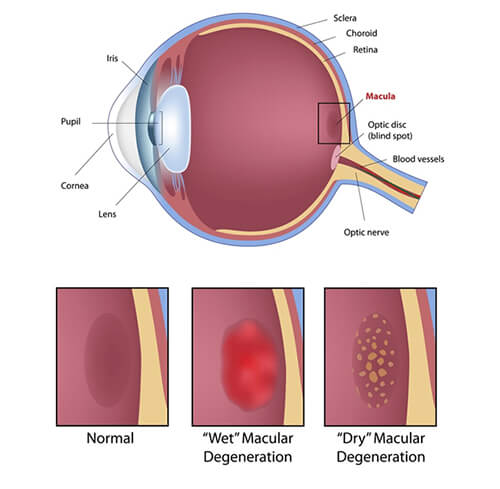

Macular degeneration, or Age-related Macular Degeneration, is a degeneration in the retina where waste material accumulates into deposits called drusen. Drusen occur in the layers just below the retina and cause dysfunction of the photoreceptors and ultimately limit vision. Over time these drusen can lead to atrophy and can damage the retina, which can reduce the eye’s ability to see fine detail and may lead to distortion.
Over time, often decades, affected areas can develop nets of bad blood vessels called choroidal neovascularization. These neovascular nets can leak and bleed, causing significant distortion, decreased vision and blind spots. When this occurs, we say the macular degeneration has become “wet.” This type of macular degeneration requires urgent intervention and may require treatment with VEGF inhibitors.
Macular degeneration can be asymptomatic for long periods of time (even decades). When symptoms do develop, the most common complaint of macular degeneration is diminished vision. However, you may also experience distortion and in some cases blind spots. Every person with macular degeneration has a different experience as the disease has a spectrum of severity.

Age is the most important risk factor. Patients older than 75 have three times the risk to develop macular degeneration than younger patients. Genetics do play a role in the development of macular degeneration, but like other diseases of the eye, the development of the disease is a result of a complex mix of genetics and environmental factors. Smoking is a significant risk factor, which can double your risk, so smoking cessation is recommended. Ultraviolet light exposure likely has a role in macular degeneration development, and sunglasses are recommended.
How will I know if I have macular degeneration?
Macular degeneration affects the part of the retina responsible for sharp and detailed vision. Often times early macular degeneration is asymptomatic. Macular degeneration patients often complain of difficulty reading, recognizing faces or distinguishing features on objects such as a clock face. Other symptoms may include distortion of images or blind spots in your vision.
Dry macular degeneration is the more common form. The characteristic findings include a buildup of waste material in clusters called drusen. Additionally, the retina can begin to atrophy, and changes in the pigment layer behind the retina can lead to clumping. All of these lead to decreased vision, distortion and blind spots. Your dilated eye exam may be able to detect the presence of drusen.
When macular degeneration becomes “wet”, a net of unhealthy blood vessels begins to form in the layers underneath the retina. These abnormal blood vessels can leak and bleed and lead to sudden changes in vision, distortion and large blind spots. This type of transformation requires urgent treatment with VEGF inhibitors to reduce the amount of leakage and bleeding.
Treatment for macular degeneration depends on the stage. Early dry macular degeneration requires regular follow up with your ophthalmologist. Your ophthalmologist will have you check an Amsler grid at regular intervals to decide if changes are occurring. They may also recommend taking an eye vitamin (AREDS2) as well as sunglasses.
Eye vitamins are a special mixture of antioxidant vitamins and nutrients shown by studies to slow the rate of progression of intermediate and advanced dry macular degeneration. The ingredients have changed slightly as more studies have been performed on the benefits of these vitamins, but the basic ingredients include Vitamins C and E, zeaxanthin, lutein, and zinc. There are many brands available on the market, and all are available without a prescription. Ask your eye doctor which one is the best choice for you.
Colorado Eye Consultants is dedicated to the preservation of sight and providing patients with the quality of life they deserve. Our patients receive personalized care by knowledgeable and experienced board certified ophthalmologists to ensure the clarity needed to see the most important things in their world. Your vision is our utmost priority and we offer same day appointments to ensure you get the care you deserve!
Request an Appointment